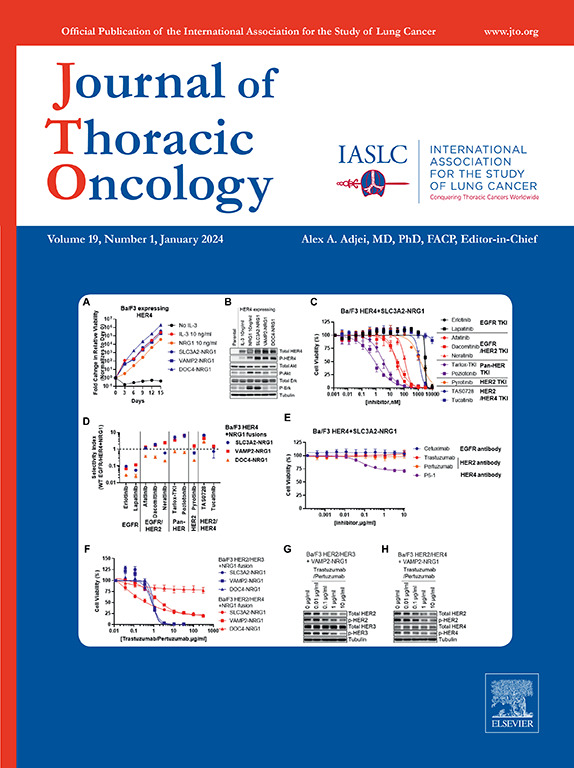偶然发现肺结节对非小细胞肺癌死亡率的预测影响。
IF 21
1区 医学
Q1 ONCOLOGY
引用次数: 0
摘要
简介尽管低剂量计算机断层扫描(LDCT)肺癌筛查降低了死亡率,但接受率仍然很低。患者接受胸部成像检查还有其他一些医疗原因,而这正是检测肺结节的独特机会:在监测、流行病学和终末结果(SEER)--医疗保险链接数据中的 NSCLC 患者队列中,上次成像时肿瘤大小的计算方法为VDT = [(T2-T1)-ln2]/ln(V2/V1),求解 V1 的直径。根据三种不同的生长模型,V1 和 V2 分别为 T1(上次成像)和 T2(诊断过程)时的肿瘤体积。10 年肺癌特异性死亡率的计算公式为:肺癌生存率 = (-0.0098 × 最大肿瘤直径) + 1.结果:1007 名患者在确诊肺癌前一年进行了胸部成像检查。确诊时肿瘤的中位尺寸为 25 毫米,在快速、中速和慢速生长模型下,预测的上次成像时肿瘤的中位尺寸分别为 12.16 毫米、17.3 毫米和 20.42 毫米。在快速生长模型下,如果在之前的成像中发现结节,死亡率将降低 7.79%;中速生长模型的相应数值为 4.5%,慢速生长模型为 2.45%:在因其他临床原因而进行的成像中识别恶性肺结节有助于减轻 NSCLC 的负担,尤其是对于不符合LDCT 条件的患者和医学上的弱势群体。我们在此表明,临床获益,尤其是侵袭性疾病患者的获益,是相当可观的。本文章由计算机程序翻译,如有差异,请以英文原文为准。
Predicted Effect of Incidental Pulmonary Nodule Findings on NSCLC Mortality
Introduction
Despite the reduction in mortality by low-dose computed tomography lung cancer screening, the uptake is still low. Patients undergo chest imaging for several other medical reasons, and this is a unique opportunity to detect lung nodules.
Methods
In a cohort of patients with NSCLC from the Surveillance, Epidemiology, and End Results-Medicare–linked data, tumor size at previous imaging was calculated as follows: volume doubling time = [(T2-T1)·ln2]/ln(V2/V1), solving for the diameter of V1. V1 and V2 are tumor volume at times T1 (previous imaging) and T2 (diagnostic procedure) according to three different growth models. The 10-year lung cancer-specific mortality was calculated as follows: lung cancer survival rate = (−0.0098 × maximum tumor diameter) + 1.
Results
A total of 1007 patients who had a chest imaging performed up to 1 year before lung cancer diagnosis were included in this study. The median size of the tumor at diagnosis was 25 mm, and the predicted median tumor size at previous imaging was 12.16 mm, 17.3 mm, and 20.42 mm under the fast, medium, and slow growth model, respectively. Under the fast growth model, a detection of the nodule at previous imaging would have yield a decrease in mortality of 7.79%; the corresponding value for the medium growth model is 4.5% and for the slow growth model 2.45%.
Conclusions
Identifying malignant lung nodules in imaging performed for other clinical reasons can help decrease the burden of NSCLC, especially for patients not eligible for low-dose computed tomography and the medically vulnerable. We reveal here that clinical benefits, especially among patients with aggressive disease, can be considerable.
求助全文
通过发布文献求助,成功后即可免费获取论文全文。
去求助
来源期刊

Journal of Thoracic Oncology
医学-呼吸系统
CiteScore
36.00
自引率
3.90%
发文量
1406
审稿时长
13 days
期刊介绍:
Journal of Thoracic Oncology (JTO), the official journal of the International Association for the Study of Lung Cancer,is the primary educational and informational publication for topics relevant to the prevention, detection, diagnosis, and treatment of all thoracic malignancies.The readship includes epidemiologists, medical oncologists, radiation oncologists, thoracic surgeons, pulmonologists, radiologists, pathologists, nuclear medicine physicians, and research scientists with a special interest in thoracic oncology.
 求助内容:
求助内容: 应助结果提醒方式:
应助结果提醒方式:


